
|

|
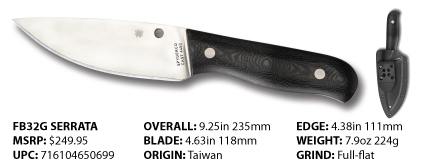
The Serrata was designed by custom knifemaker Stuart Ackerman. Currently living in New Zealand, Ackerman is a native of South Africa and a veteran of combat service in Namibia and Angola. During his time as an infantry soldier, he learned a lot about what a survival knife really needs to do. That experience, along with his natural fascination with knives, both inspired and guided his efforts as a knifemaker and designer.
Ackerman designed the Serrata as the consummate utility cutting tool. It combines the familiar look and versatility of a kitchen knife with an ergonomic handle that offers hands of all sizes comfort and control no matter how it is gripped. The blade’s full-flat grind and distal taper allow it to have a thick spine for strength, yet still provide low-friction cutting performance and excellent point utility. In Ackerman’s words, “Hold a Serrata edge up, edge down, reverse grip, you name it, and it feels like it belongs.”
The Serrata is unique because its blade is made of cast 440C steel. This process involves making a wax model of the blade and then encasing the wax in a mold. When the mold is heated, the wax melts and leaves a cavity in the mold shaped exactly like the wax blade. Molten steel is then poured into the mold to create a pre-shaped blade, which is then heat treated, ground, and polished.
Unlike traditional rolled steel, cast steel creates a dendritic (“fern-like”) crystalline structure. Pioneered by knifemaker David Boye in 1981, this process infuses microscopic crystals into the steel that create microserrations along the edge. These microserrations increase the blade’s “bite” into the material being cut and enable it to retain its sharpness significantly longer than traditional steels. The crystal structure of dendritic steel gives its surface a distinctive look that sometimes includes minor pits created during the casting process. It also makes it somewhat more susceptible to minor surface scratches. These characteristics are completely normal and are part of the character of this G-10.
The Serrata features a plain-edged, full-flat-ground blade and full-tang construction. Its black G-10 handle scales are secured by stainless steel cutler’s bolts and meticulously contoured to provide a hand-filling grip devoid of hot spots. The heel of the edge (the area closest to the handle) is also purposely blunted to provide an extra measure of safety during use.
To protect the blade when not in use and allow convenient carry of the Serrata, it comes with a custom-molded Boltaron® sheath. The mouth of the sheath provides a snap fit around the forward portion of the knife’s handle to retain it securely during vigorous activity. A G-Clip allows the sheath to be carried on the belt or clipped to clothing in a variety of different positions. The symmetrical design of the sheath also allows the G-Clip to be attached to either side, making it fully adaptable to left or right-side carry and both dominant-side and cross-draw carry positions.
The Serrata combines the hard-won real-world experience of its designer with advanced manufacturing methods to yield a knife that is purpose built for reliable high-performance.
|

|

|
STUART ACKERMAN
Stuart Ackerman is a knifemaker who specializes in extremely practical, incredibly functional designs inspired by his own real-world experience. A native of South Africa, Ackerman served as an infantryman in the Angolan Bush War. His experiences as a field soldier taught him the value of a good knife and helped him understand the qualities that really define practical cutting tools.
Ackerman made his first knife in 1975 out of 01 tool steel and Pakkawood scales using only hand files, wet/dry sandpaper, and an old hand drill. It was inspired by a Bill Moran skinner he had seen in Guns and Ammo magazine and was fitted with a Kydex sheath he made sometime later. That knife, which he still has, was followed by several similar knives that he gave away to friends. With each one, his skills and knowledge of the process improved.
In 1992, Ackerman built his first grinder and a month later exhibited at the Durban, South Africa Easter Knife Show. It was at that show he sold his first knife—a simple drop point design with a hollow-ground N690 blade and wild olive wood scales. The buyer of that knife liked its simplicity, and after using it on a hunt, returned to buy many more of Ackerman’s blades. Another of the knives Ackerman sold at that show was featured in an article by the hunting editor of South Africa’s Magnum magazine. That exposure put Ackerman on the map as a knifemaker and there was no turning back.
An electrician by trade, Ackerman is a part-time knifemaker who focuses primarily on crafting utility knives, hunters, and skinners for customers who really intend to use them. Although he does do special orders for military personnel, even those designs emphasize utilitarian application. Based on his personal experience, most of his knives feature 4-5-inch blades made from thick, durable stock meticulously ground to achieve proper edge geometry. He works primarily in N690, VG10, and 12C27 steels for smaller knives and O1 and 1095 for kukris, machetes, and camp knives.
After reading an article in Knives Illustrated magazine about David Boye and his work with investment cast 440C steel, Ackerman became intrigued with that material and its potential for knives. Following his move to New Zealand in 1999, he began researching the process and working found a local caster willing to work with him on knife projects.
In 2005, Ackerman designed the Serrata, which means “small teeth” in Latin. He felt that it was an ideal design for the lost wax casting process, so he made a mold, did a sample run, and tested the resulting blades. Even in their annealed state, they cut impressively, so he moved forward and has done eight batches to date. He sharpens his custom blades to a maximum 400-grit edge, which he feels is the optimum “toothy” cutting edge for this blade material.
Although Ackerman has made a wide range of knife styles, the Serrata is still his favorite. It comes as close as possible to a true “one-size-fits-all” utility knife and when rendered in cast 440C provides exceptional cutting performance. Spyderco is proud to have worked with Ackerman to make this uniquely functional knife commercially available and we’re confident that it will become the favorite of many other knife users in the very near future.
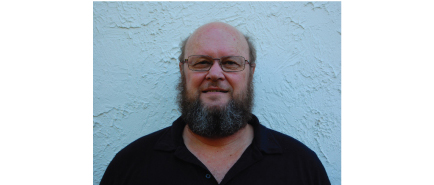
|

|

|
DENDRITIC STEEL
“Dendritic steel” is a term coined by knifemaker David Boye to describe the cast 440C stainless steel he developed in 1981. Meaning “fern-like” in Greek, “dendritic” steel is so named because of its unique crystalline structure.
The process for creating this steel is also unique. Unlike the traditional rolling process, which creates steel sheet with a uniform thickness and grain pattern, dendritic steel is produced by the investment casting process. Also known as “lost wax” casting, this method begins with a wax model of the knife blade. This model is repeatedly dipped in a ceramic mixture that is allowed to harden into a mold. When the mold is heated in a furnace to cure it, the wax melts and flows out, leaving an empty cavity. Molten steel is then poured into the cavity and allowed to cool and solidify. The mold is then broken and the blades—already substantially formed—are heat treated and ground to final form.
The primary advantage of dendritic steel is that the microscopic crystals in the steel’s matrix create a series of micro-serrations along the blade’s cutting edge. The “toothiness” of these serrations enables the blade to “bite” more aggressively during cutting actions, increasing its cutting performance on slippery, soft, and fibrous materials. The micro-serrations also significantly improve the knife’s edge-retention properties, enabling it to stay sharper much longer than conventional steel blades.
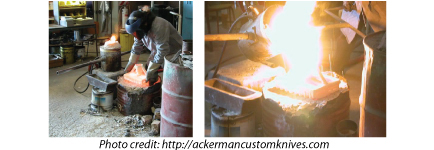
|

|

|
2014 SHOT SHOW
The 36th annual Shooting, Hunting, and Outdoor Trade Show (The SHOT Show®) was January 14-17 at the Sands Convention Center in Las Vegas, Nevada. This is not just one of the world’s biggest gun shows but a four-day event attended by more than 67,000 industry representatives from around the world, it constitutes 32-hours of blow-out, riotous knife, firearms and accessory overload.
Although the show is not open to the public, it is attended by retail store owners, outfitters and buyers-the people bringing Spyderco knives and accessories to our end-line-users, as well as, military & law enforcement personnel.
Spyderco introduced a number of new knife models ready to release during the first half of 2014; many of these were seen for the first time during the show. From now until year’s end look for a new Spyderco large folder, the Tatanka, a Peter Carey/Spyderco collaboration called the Firefly, a Mike Draper Folder and the release of the C06TIP Tusk CLIPIT which has been under-wrap and in development for twenty-five years.
Spyderco has two booths during the show. Our primary general interest booth (we call it the Mother Ship) is our Main Booth. Here we display the entire Spyderco product line and have two prototype cases highlighting future concept and prototype models. This booth was manned by the Glesser Family, Spyderco’s Sales and Marketing Teams and several star collaborative knifemakers including Ed Schempp, Gayle Bradley and Phil Wilson.
We also had an OpFocus Booth in the Military/Law enforcement section of the show, hosted by our Government Sales and Marketing Team. They specialize in sharing Spyderco knives from a survivalist, military, law enforcement and self defense perspective.
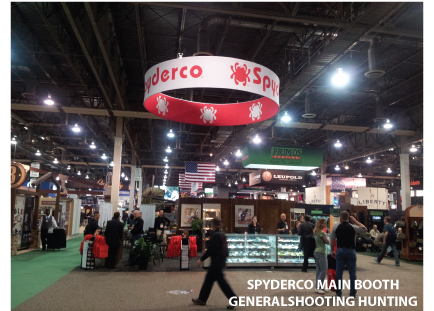
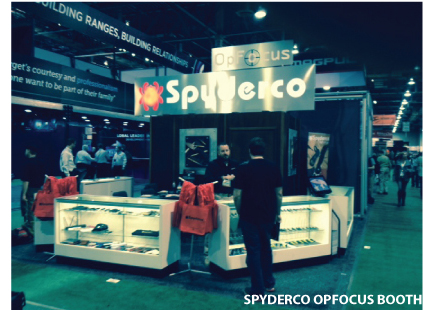
|
|








